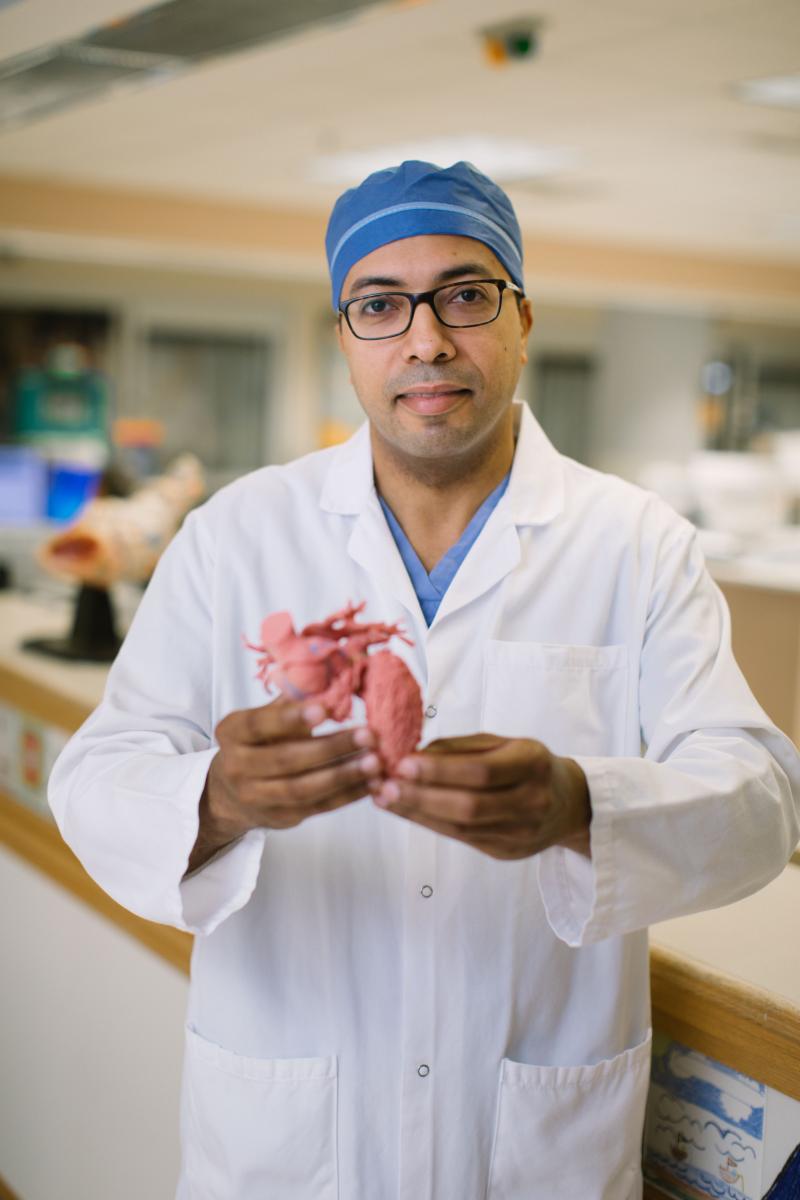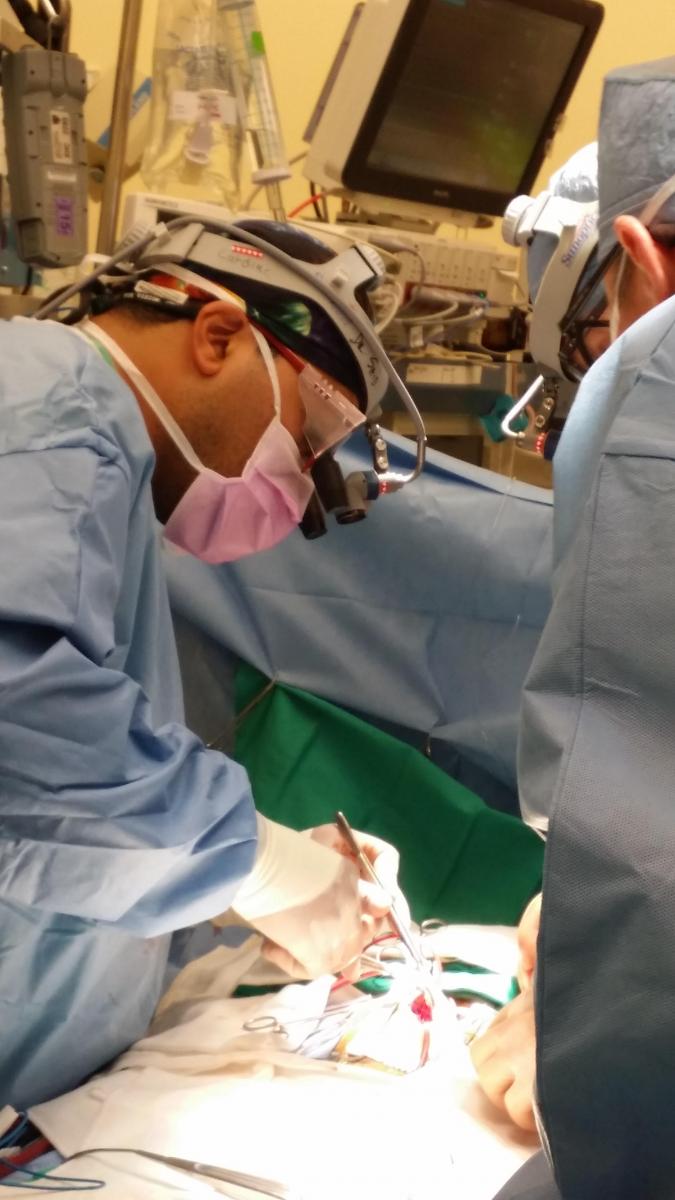ALERT!
This site is not optimized for Internet Explorer 8 (or older).
Please upgrade to a newer version of Internet Explorer or use an alternate browser such as Chrome or Firefox.
Featured Profile: Dr. Sameh Said
 When Dr. Sameh Said came to the United States in 2005 for an advanced cardiovascular surgical fellowship at Mayo Clinic, he expected to return to his home country of Egypt, where he earned his medical degree and completed his residency, the following year. Instead, he spent the next thirteen years living and working in Minnesota and building his impressive pediatric cardiac surgery career, including a second residency in the U.S. and a fellowship at Lucile Packard’s Children’s Hospital in Palo Alto, California. Today, Dr. Said is the chief of the division of pediatric and adult congenital cardiac surgery at Maria Fareri Children’s Hospital, Westchester Medical Center and New York Medical College in Valhalla, New York.
When Dr. Sameh Said came to the United States in 2005 for an advanced cardiovascular surgical fellowship at Mayo Clinic, he expected to return to his home country of Egypt, where he earned his medical degree and completed his residency, the following year. Instead, he spent the next thirteen years living and working in Minnesota and building his impressive pediatric cardiac surgery career, including a second residency in the U.S. and a fellowship at Lucile Packard’s Children’s Hospital in Palo Alto, California. Today, Dr. Said is the chief of the division of pediatric and adult congenital cardiac surgery at Maria Fareri Children’s Hospital, Westchester Medical Center and New York Medical College in Valhalla, New York.
Dr. Said’s varied training has resulted in a broad array of interests across cardiac and congenital specialties. He values teaching and education and aims to make them a part of his practice. He is married to a pharmacist and has three children. Dr. Said enjoys traveling, art, learning new languages, and is halfway through earning his part-time MBA.
Read on for an interview with Dr. Said including his take on innovations in cardiac surgery, his favorite leadership advice, and more. The conversation has been edited for length and clarity.
CTSNet: You received your medical degree in Egypt and then completed your residency in the United States. What was the most interesting or valuable aspect of pursuing training in a different country?
Dr. Said: I received my medical degree and initial cardiothoracic surgical training in Egypt, then became board certified after completing a formal residency in the USA. The most interesting aspect of pursuing training in a different country is the cultural difference I faced when moving to a new country. When I came to the US, my English was not good, but it got better over time. I learned how to talk to patients and families from watching my staff. In my initial fellowship, there were multiple fellows from different countries, and we shared only our interest in cardiac surgery, but we all had different cultural backgrounds and we learned from each other, which was quite helpful.
Then came the technological differences and the technical aspects of our job, learning new skills, and seeing different tools; this was the whole point of pursuing advanced training somewhere else. I came to the US and had never seen a Swan-Ganz catheter or an intra-aortic balloon pump, for example. I remember spending hours in the hospital with technicians, nurses, and respiratory therapists to learn all this so I could take care of my patients.
And finally, the ability to do research and have a question to which you can find an answer or try to find an answer. These in my mind are the three most valuable aspects of pursuing training in a different country.
CTSNet: What is the biggest advance you have seen in cardiac surgery recently?
Dr. Said: There are so many advances that I have seen in cardiac surgery in general, and pediatric cardiac surgery in particular, over the years. These advances can be divided into three major aspects: (1) advances in diagnostic tools, (2) advances in therapy, and (3) advances in approaches. Advances in diagnostics include the use of 3D models for the patient’s heart, where the surgeon can pretty much perform the operation prior to going into the patient’s chest. Advances in therapy include examples like the ability to perform complex repair of certain heart defects in a 2.5 or 3 kg baby, which seemed to be nearly impossible fifty or sixty years ago, or the ability to place a valve inside the heart with the transcatheter option. Advances in approaches include the use of minimally invasive or minimal access to repair heart defects in children, replace a valve, or do a coronary artery bypass graft in adults.

CTSNet: What is the biggest challenge facing cardiac surgery right now?
Dr. Said: In my mind, the biggest challenge is the ability to train residents and fellows, and this is for a few reasons.
One reason is that the fast rhythm of heart surgery and the evolution of new technology almost every day makes it difficult for trainees, or even young practicing surgeons, to catch up on all these technologies, as you do not have enough years in the program to cover everything. Residents need to be competent in open procedures, complex root surgery, transcatheter therapy and ventricular assist devices, and minimally invasive, etc., and at the same time do research. This is extremely difficult to achieve within only four to five years of training. Then you get a graduating resident who is good in a few things, and when starting a job as an attending, they will need support from senior colleagues. This is not always easy to find, but how this new faculty will be able to teach new residents in the program and so on.
Another reason is the expectations from the cardiologists and from the public are high these days, meaning you cannot have a bad outcome, even in the most complex procedures, so we do not have the luxury of the past era where bad outcomes were not uncommon, and in some situations, even acceptable. This adds another layer that makes it difficult for trainees to get a chance at a difficult procedure, other than watching or assisting in it.
Finally, the burnout and the need to give everyone a break and work-life balance, etc. These were not an issue when I was a resident. I was in the hospital, taking care of my patients until they left. No breaks, and I was not going anywhere. I remember working with a very busy surgeon who used to do four to five cases a day, and I covered their service for nine months continuously with no single day off. I was actually quite happy because I was learning every single day. This is no longer an option, so how can trainees find enough time to learn all this?
CTSNet: If you had a magic wand to create the next innovation in CT surgery, what would it be?
Dr. Said: I would wish for several innovations in the field of pediatric and congenital heart surgery: in fetal interventions where we can repair heart defects or prevent them prior to delivery; the development of bioengineered hearts, valves, and conduits that can grow with the child, which is already happening; and utilization of advanced stem cell therapy to treat failing hearts. These are some of many.
CTSNet: Technical skill is obviously important for surgeons, but can you address the importance of leadership skills and the capacity to foster the surgical team’s success?
Dr. Said: Leadership skills are key to the success of any practice and/or any program. I have seen the bad leader who only cares about themself and the good leader who pushes everyone around them to be better. These leadership skills are critical, and they are not taught during our training, but rather something we gain over time and from watching others who are both good and bad leaders. Obviously, major organizations now have paid attention to this issue and there are several leadership courses that are helpful to surgeons. I think it is important to always listen and read about what other leaders do. Leadership is an action, not a position, and the key to successful leadership is influence, not authority. One of the best quotes I read about leadership was by Nelson Mandela who said, “A leader is like a shepherd. He stays behind the flock, letting the most nimble go out ahead, whereupon the others follow, not realizing that all along they are being directed from behind.” Failing organizations are usually overmanaged and under-led, and I think that summarizes everything.

CTSNet: What is your favorite procedure? Why is it your favorite?
Dr. Said: There are several procedures that are my favorite indeed, such as Ross, arterial switch, septal myectomy for hypertrophic cardiomyopathy, etc. But I love it when I am doing pulmonary arterial branch reconstruction and/or unifocalization procedures because these are quite long and challenging operations that require careful planning and need a special set of skills that cannot be performed except by a few surgeons. These procedures change a patient’s life but also speak to the skills and precision the surgeon has.
CTSNet: You’ve received an impressive list of awards. Please choose one to explain.
Dr. Said: Thank you. The best thing I receive is always the card from the parents whose child I operated on, and the pictures they send me after surgery. This always makes my day and is why I do what I do. There is a particular mom whose son I performed an arterial switch on almost six years ago, and she sends me his birthday picture every year, which really makes me happy and always reminds me to do my best.
CTSNet: How important is the international exchange of ideas, information, and techniques in cardiothoracic surgery?
Dr. Said: It is extremely important. I learn a lot from other surgeons and colleagues when we share ideas about a particular technique or certain approach. Everyone has their own little tricks and tips that help. Whether these discussions occur on a platform like Twitter or during international meetings like the EACTS or AATS, they are extremely helpful. In fact, CTSNet plays a major role in this through the operative videos that we get the opportunity to share and the webinars that include surgeons from all over the world.
CTSNet: How can we best or most efficiently effect change in the professional areas we are most passionate about?
Dr. Said: This is a great question. This should be based on several major steps: (1) We have to have a plan. Change for change’s sake is indeed disruptive, so proper planning is the key. (2) We have to set goals and expectations. (3) We have to define that change for everyone at the beginning and answer their questions. (4) Any change comes with a risk, so we have to clarify the challenges we will face when making these changes. (5) We have to listen to everyone’s concerns. What major centers do often is ignore their employees for the sake of the change, but this is how things end up badly sometimes. (6) Finally, we have to set new performance objectives.
Disclaimer
The information and views presented on CTSNet.org represent the views of the authors and contributors of the material and not of CTSNet. Please review our full disclaimer page here.





Comments